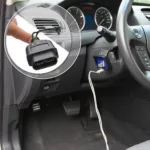Resetting your car’s adaptive transmission with an OBD2 scanner can often improve shifting performance. This guide explores the process, benefits, and potential risks involved in resetting your adaptive transmission using an OBD2 scanner. We’ll cover various aspects of this procedure, from understanding how adaptive transmissions work to choosing the right OBD2 scanner for the job.
Understanding Adaptive Transmissions
Adaptive transmissions, also known as “learning” transmissions, constantly adjust their shift patterns based on your driving habits. This adaptation is designed to optimize fuel economy and provide a smooth driving experience. However, sometimes the learned data can become corrupted or less than ideal, leading to rough shifts, delayed engagement, or poor fuel economy.
After you’ve driven for a while, your car’s adaptive transmission “learns” your driving style and adjusts accordingly. This can be great for optimizing performance, but sometimes it’s necessary to reset the system. An OBD2 scanner can be a valuable tool for this. Some scanners, like the Snapon OBD2 reader, offer advanced functionalities beyond just reading codes.
Why Reset Your Adaptive Transmission?
There are several reasons why you might consider resetting your adaptive transmission:
- Rough Shifting: If your car is experiencing jerky or harsh shifts, resetting the adaptation can often smooth things out.
- Delayed Engagement: A reset can sometimes resolve issues with delayed gear engagement.
- Improved Fuel Economy: While not always guaranteed, a reset can potentially improve fuel efficiency.
- After Repairs: If you’ve had work done on your transmission, a reset allows the system to relearn with the new components.
- Software Updates: After a vehicle software update, a transmission reset might be necessary to ensure compatibility.
How to Reset Adaptive Transmission with OBD2
The exact process for resetting your adaptive transmission with an OBD2 scanner varies depending on the vehicle make, model, and the specific scanner you’re using. However, the general steps are as follows:
- Connect the OBD2 Scanner: Plug the scanner into your vehicle’s OBD2 port, usually located under the dashboard.
- Turn on the Ignition: Turn the key to the “on” position without starting the engine.
- Access Transmission Module: Navigate to the transmission control module (TCM) within the scanner’s software.
- Locate Reset Function: Find the option to reset or relearn the adaptive transmission. This might be labeled as “reset,” “relearn,” “adaptation reset,” or something similar.
- Follow On-Screen Prompts: Follow the instructions provided by the scanner’s software.
- Test Drive: After the reset, take your car for a test drive to allow the transmission to relearn your driving style.
If you need Chrysler-specific software, check out resources like OBD2 Chrysler software or explore Chrysler OBD2 programming software. Finding the right software can significantly impact the effectiveness of your reset procedure.
Potential Risks and Considerations
While resetting your adaptive transmission is generally safe, there are a few potential risks to be aware of:
- No Improvement: Resetting the transmission doesn’t always guarantee improved performance. If the underlying issue is mechanical, a reset won’t fix it.
- Temporary Rough Shifting: You might experience some rough shifting immediately after the reset while the transmission relearns. This is usually temporary.
- Voiding Warranty: In some cases, using an OBD2 scanner to modify vehicle settings might void your warranty. Check with your manufacturer or dealer.
Choosing the Right OBD2 Scanner
Choosing the right OBD2 scanner is crucial for successfully resetting your adaptive transmission. Some basic scanners can only read and clear codes, while more advanced scanners offer features like transmission relearn procedures. Consider factors like vehicle compatibility, software features, and user-friendliness when selecting a scanner. Resources like OBD2 scan tool Autel can offer valuable insights into choosing a suitable OBD2 scanner.
“When choosing an OBD2 scanner for transmission resets, it’s essential to consider its compatibility with your vehicle’s make and model,” advises John Smith, Senior Automotive Technician at Smith Automotive. “Some scanners are designed for specific manufacturers, offering more comprehensive functionalities for those vehicles.”
Conclusion
Resetting your adaptive transmission with an OBD2 scanner can be a simple and effective way to improve shifting performance and address certain transmission issues. However, it’s important to understand the process, choose the right scanner, and be aware of the potential risks involved. By following the steps outlined in this guide and using the correct tools, you can potentially restore your transmission to optimal operation. For specific Chrysler software needs, consider options like free OBD2 Chrysler flashing software download.
FAQ
- Will resetting my adaptive transmission fix all transmission problems? No, a reset won’t fix mechanical issues.
- Is it safe to reset my adaptive transmission? Generally, yes, but be aware of potential risks.
- How often should I reset my adaptive transmission? Only when necessary, such as after repairs or if experiencing shifting problems.
- What if I don’t have an OBD2 scanner? You can often have this done at a repair shop.
- Can I damage my transmission by resetting it? It’s unlikely, but using an incompatible scanner or incorrect procedure could cause issues.
- Will a reset improve my fuel economy? Potentially, but it’s not guaranteed.
- How long does the reset process take? It usually takes just a few minutes.
“Remember, a transmission reset is just one tool in diagnosing and addressing transmission issues,” adds Jane Doe, Certified Automotive Technician at Doe’s Auto Repair. “If you continue to experience problems after a reset, it’s crucial to consult a qualified mechanic for a thorough inspection.”
For further assistance, please contact us via WhatsApp: +1(641)206-8880, or Email: [email protected]. Our customer support team is available 24/7.
